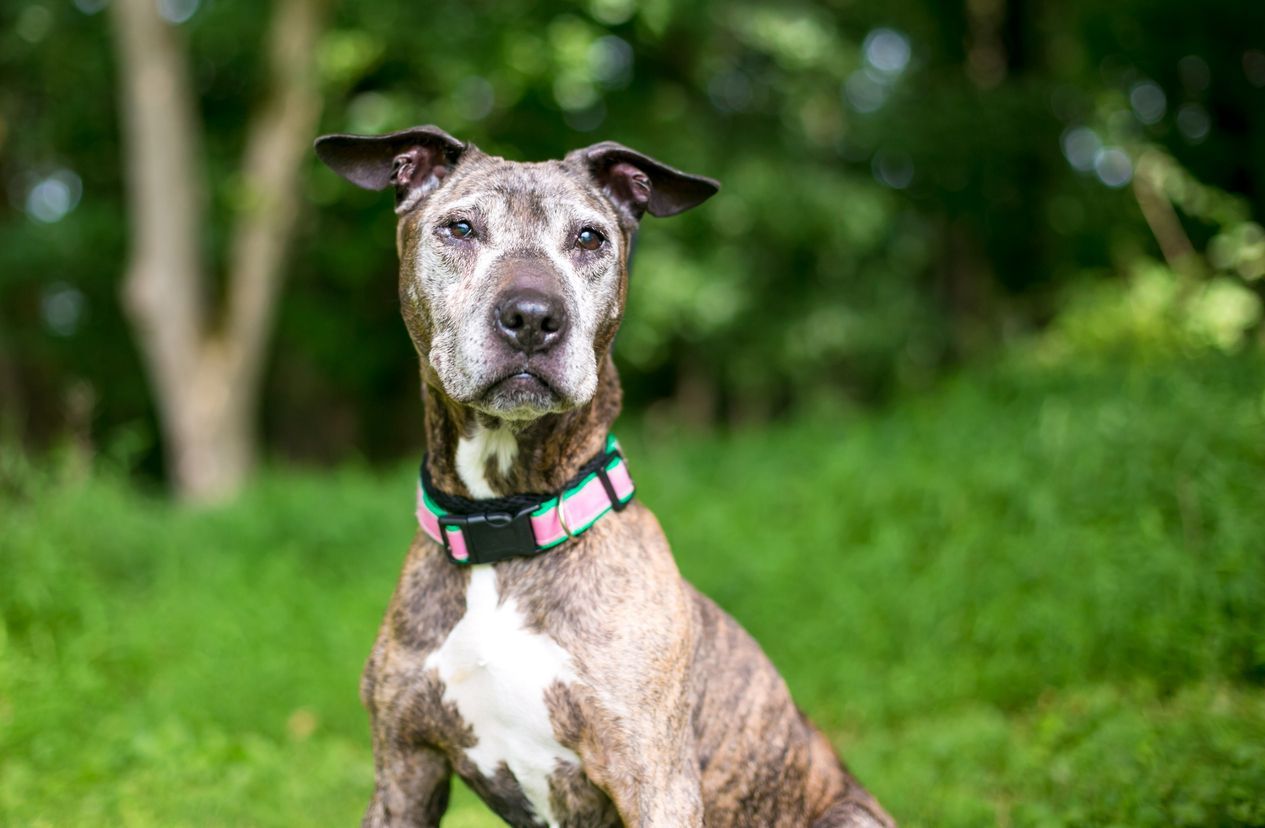Weak hind legs in senior dogs: Causes and treatment options

Disclaimer: This article, its content, and its related references do not constitute veterinary advice and should not be considered a substitute for veterinary care. If your pet is showing any symptoms that could indicate a medical emergency, please seek immediate emergency care.
There are many potential causes for a dog’s hind legs to seemingly become weak or give out. As dogs age, there are some health conditions that are more likely than others to be the underlying cause. These include arthritis, hip dysplasia, cancer, certain metabolic conditions, and conditions affecting the nervous system, such as intervertebral disk disease and degenerative myelopathy. If your senior dog has mobility issues affecting their back legs, read on to learn:
- Clinical signs associated with mobility issues
- Potential causes for a loss of back leg mobility
- How mobility concerns are diagnosed and treated
- What to do if your dog is having mobility challenges
Senior dogs are more likely than younger dogs to have poor joint health, metabolic conditions, heart disease, and other health issues that can affect mobility. It’s important to have a veterinarian assess your dog and get an accurate diagnosis if your older dog is having mobility concerns, even if the problem seems sporadic or your dog appears otherwise healthy. Treatment of mobility issues varies depending on the underlying cause. These conditions are likely to be chronic in senior dogs, but long-term management can improve symptoms and overall quality of life.
What does hind end weakness look like in dogs?
A normal gait in dogs has equal weight on all four limbs without favoring a particular limb or showing stiffness in the joints. Various clinical signs can make a dog’s legs appear like they are collapsing:
- Collapse: Falling to the floor and being unable to get back up
- Ataxia: Poor coordination and appearing to walk “drunk”
- Paralysis: Inability to move or feel in one or more limbs
- Paresis: Partial paralysis in one or more limbs
- Limping: Walking abnormally with uneven weight on the affected limb or limbs (lameness)
- Weakness: Moving slowly and struggling to rise from rest; may have muscle shaking
Multiple health conditions can lead to these symptoms, making it appear that a dog’s back legs are giving out. Some conditions can affect any dog, while others are age-related and are more likely to develop in seniors.
Health conditions that can cause back leg weakness in senior dogs
There are many medical conditions that can lead to limited mobility in dogs. Some are more likely to affect senior dogs.
Osteoarthritis and other musculoskeletal conditions
Osteoarthritis is a very common condition in senior dogs that leads to a reduction in mobility due to joint pain and stiffness resulting from degeneration within the joint over time. Other conditions that affect a senior dog’s musculoskeletal system that lead to mobility problems include:
- Elbow or hip dysplasia
- Ligament degeneration or rupture (torn ACL or CCL)
- Dislocating kneecaps (luxating patellas)
- Joint infection
- Bone cancer (osteosarcoma)
Signs of arthritis and other musculoskeletal problems in older dogs are usually gradual rather than appearing suddenly. Most conditions are progressive and get worse over time.
Neurologic disorders
Various conditions that affect the nervous system can lead to ataxia, weakness, and mobility problems in older dogs. These include:
- Intervertebral disc disease
- Degenerative myelopathy
- Vestibular disease
- Spinal or brain tumors
- Stroke
Degenerative myelopathy (DM) is a neurologic condition that causes progressive paralysis in dogs, usually starting in the hind limbs. Symptoms most often start in dogs that are middle-aged or older.
Another common neurologic condition in senior dogs is idiopathic vestibular disease. The vestibular system is the system that helps to control balance and orientation. Vestibular disease can cause a lack of coordination as well as other neurologic symptoms that affect how a dog walks. In seniors, it’s often idiopathic, meaning there’s no identifiable cause. It can also be caused by anything that affects the vestibular system, such as ear infections.
Metabolic conditions
Various metabolic disorders that can lead to hind leg weakness are common in senior dogs but uncommon in young dogs. Metabolic conditions that can affect a dog’s ability to walk normally include:
These conditions can cause collapse or weakness in dogs for various reasons, such as electrolyte abnormalities or muscle loss.
Other health issues
Various other medical issues in dogs can lead to weakness, lameness, collapse, and ataxia. These can include:
- Obesity
- Traumatic injury
- Exposure to toxins
- Heart disease
- Infectious disease
- Various cancers and tumors
Because there are so many health issues that can cause mobility loss in senior dogs, it’s important to get an accurate diagnosis from a veterinarian in order to receive appropriate treatment.
Diagnosing and treating the cause of an older dog’s back legs giving out
When a dog presents with mobility concerns, the first step is for a veterinarian to identify the main clinical signs: weakness, ataxia, paralysis, paresis, collapse, or lameness. This can help narrow down the possible causes. Diagnostic tests may be recommended to determine the underlying cause of the symptoms, including:
- Physical examination
- Neurologic exam
- Blood tests
- Diagnostic imaging, such as X-rays, ultrasound, MRI, or CT scans
- Urinalysis
An effective treatment plan will vary depending on the diagnosis. Treatment may include:
- Medications for pain relief, inflammation, infection, and other issues
- Supportive care, such as mobility aids and home modifications
- Management of underlying medical conditions
- Weight management or diet change
- Treating injuries or toxicosis
- Physical therapy
- Surgery for certain conditions
Many health concerns that affect a senior dog’s mobility are chronic conditions that can’t be cured. However, many of those conditions—including arthritis, metabolic disorders, and vestibular disease—can be managed with medication and support at home. It’s important to seek an accurate diagnosis from a veterinarian rather than assuming your dog’s symptoms are due to old age. Management of age-related health issues can improve a senior dog’s quality of life, even if the disease itself can’t be cured.
What to do if your senior dog is having mobility issues
“It’s important to seek veterinary care if your dog is having mobility challenges, even if they seem otherwise healthy,” explains Dr. Jamie Lecky, a veterinarian on the Vetster platform. “Don’t assume they’re slowing down simply due to old age.” While they may have an age-related health issue, many of those issues can be managed with medication, diet, and other forms of treatment to improve symptoms and overall quality of life.
Never give a dog human medication without consulting a vet first, as many are toxic to dogs. If your dog appears to be in enough pain to consider pain medication at home, a vet visit is warranted. Always seek emergency care in the case of:
- Collapse or sudden inability to walk
- Loss of consciousness
- Difficulty breathing
- Paralysis of one or more limbs
- Mobility issues that are accompanied by other signs of illness
For symptoms that aren’t an emergency, prompt treatment can help catch conditions early, which can sometimes make them more manageable for a longer period of time. If you’re unsure if your senior’s gait is normal, an online vet can help by observing them at home. Online virtual vet appointments are also a great tool to help manage chronic conditions and quickly check in with a vet on changing symptoms.
FAQ - Weak hind legs in senior dogs: Causes and treatment options
What should I do if my old dog’s back legs have collapsed?
It’s important to seek emergency veterinary care if your dog has collapsed or has lost consciousness. There are a variety of conditions that can cause hind leg weakness, paralysis, collapse, and other symptoms. Some of these issues are considered medical emergencies.
Why is my senior dog losing balance on their back legs?
Many age-related medical conditions can lead to hind leg collapse, weakness, lameness, or loss of coordination or balance. Neurologic disorders, joint diseases, heart conditions, and a wide variety of other health issues can affect a senior dog’s balance. It’s important to seek prompt veterinary care for an accurate diagnosis and proper treatment.
What causes a dog’s back legs to give out?
There are many reasons why a dog’s legs may appear to give out. Common reasons for hind leg collapse in senior dogs include osteoarthritis, intervertebral disc disease, metabolic disorders, vestibular disease, heart disease, and degenerative myelopathy. Because there are a wide variety of conditions that can cause a dog’s back legs to give out, it’s important to seek prompt veterinary care for an accurate diagnosis and appropriate treatment.



